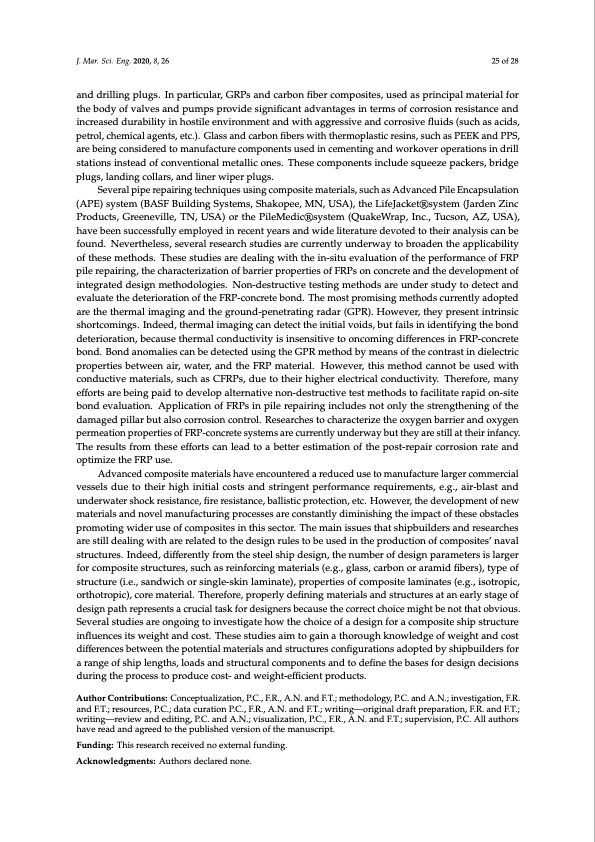
PDF Publication Title:
Text from PDF Page: 025
J. Mar. Sci. Eng. 2020, 8, 26 25 of 28 and drilling plugs. In particular, GRPs and carbon fiber composites, used as principal material for the body of valves and pumps provide significant advantages in terms of corrosion resistance and increased durability in hostile environment and with aggressive and corrosive fluids (such as acids, petrol, chemical agents, etc.). Glass and carbon fibers with thermoplastic resins, such as PEEK and PPS, are being considered to manufacture components used in cementing and workover operations in drill stations instead of conventional metallic ones. These components include squeeze packers, bridge plugs, landing collars, and liner wiper plugs. Several pipe repairing techniques using composite materials, such as Advanced Pile Encapsulation (APE) system (BASF Building Systems, Shakopee, MN, USA), the LifeJacket®system (Jarden Zinc Products, Greeneville, TN, USA) or the PileMedic®system (QuakeWrap, Inc., Tucson, AZ, USA), have been successfully employed in recent years and wide literature devoted to their analysis can be found. Nevertheless, several research studies are currently underway to broaden the applicability of these methods. These studies are dealing with the in-situ evaluation of the performance of FRP pile repairing, the characterization of barrier properties of FRPs on concrete and the development of integrated design methodologies. Non-destructive testing methods are under study to detect and evaluate the deterioration of the FRP-concrete bond. The most promising methods currently adopted are the thermal imaging and the ground-penetrating radar (GPR). However, they present intrinsic shortcomings. Indeed, thermal imaging can detect the initial voids, but fails in identifying the bond deterioration, because thermal conductivity is insensitive to oncoming differences in FRP-concrete bond. Bond anomalies can be detected using the GPR method by means of the contrast in dielectric properties between air, water, and the FRP material. However, this method cannot be used with conductive materials, such as CFRPs, due to their higher electrical conductivity. Therefore, many efforts are being paid to develop alternative non-destructive test methods to facilitate rapid on-site bond evaluation. Application of FRPs in pile repairing includes not only the strengthening of the damaged pillar but also corrosion control. Researches to characterize the oxygen barrier and oxygen permeation properties of FRP-concrete systems are currently underway but they are still at their infancy. The results from these efforts can lead to a better estimation of the post-repair corrosion rate and optimize the FRP use. Advanced composite materials have encountered a reduced use to manufacture larger commercial vessels due to their high initial costs and stringent performance requirements, e.g., air-blast and underwater shock resistance, fire resistance, ballistic protection, etc. However, the development of new materials and novel manufacturing processes are constantly diminishing the impact of these obstacles promoting wider use of composites in this sector. The main issues that shipbuilders and researches are still dealing with are related to the design rules to be used in the production of composites’ naval structures. Indeed, differently from the steel ship design, the number of design parameters is larger for composite structures, such as reinforcing materials (e.g., glass, carbon or aramid fibers), type of structure (i.e., sandwich or single-skin laminate), properties of composite laminates (e.g., isotropic, orthotropic), core material. Therefore, properly defining materials and structures at an early stage of design path represents a crucial task for designers because the correct choice might be not that obvious. Several studies are ongoing to investigate how the choice of a design for a composite ship structure influences its weight and cost. These studies aim to gain a thorough knowledge of weight and cost differences between the potential materials and structures configurations adopted by shipbuilders for a range of ship lengths, loads and structural components and to define the bases for design decisions during the process to produce cost- and weight-efficient products. Author Contributions: Conceptualization, P.C., F.R., A.N. and F.T.; methodology, P.C. and A.N.; investigation, F.R. and F.T.; resources, P.C.; data curation P.C., F.R., A.N. and F.T.; writing—original draft preparation, F.R. and F.T.; writing—review and editing, P.C. and A.N.; visualization, P.C., F.R., A.N. and F.T.; supervision, P.C. All authors have read and agreed to the published version of the manuscript. Funding: This research received no external funding. Acknowledgments: Authors declared none.PDF Image | Marine Application of Fiber Reinforced Composites

PDF Search Title:
Marine Application of Fiber Reinforced CompositesOriginal File Name Searched:
jmse-08-00026.pdfDIY PDF Search: Google It | Yahoo | Bing
Development of a solar powered Electric Ship The Electricship website originally started off as a project to develop a comprehensive renewable, affordable, modular electric ship... More Info
Modular Boat Hull Composite The case for a unsinkable, modular composite hybrid boat hull... More Info
MS Burgenstock Hybrid Electric Catamaran Lake Lucerne Unique shuttle servicing Lucerne to the Burgenstock Resort... More Info
Ground Power Unit GPU Powered by Lithium Ion Batteries The goal of the Ground Power Unit is to provide a readily accessible, modular, ready-to-power solution for remote power... More Info
| CONTACT TEL: 608-238-6001 Email: greg@electricship.com | RSS | AMP |